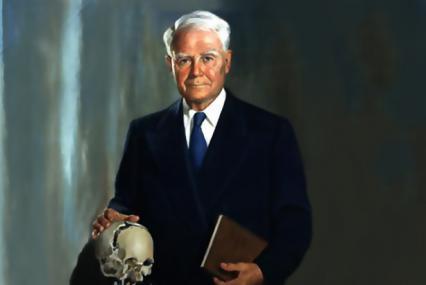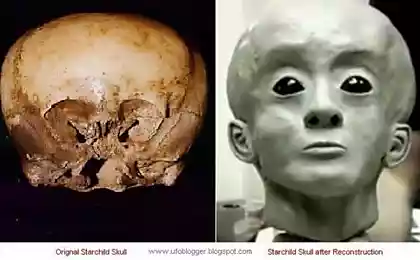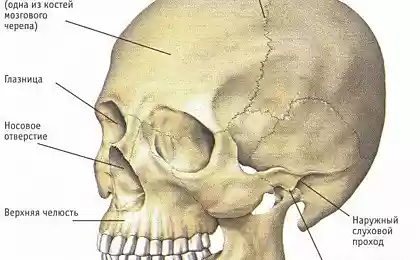565
Cranial breathing — a surprising discovery by William garner Sutherland
The contribution of this osteopath was the opening of the "cranial rhythmic impulse" — a fundamental discovery, which, however, was recognized by the American Academy of osteopathy only 40 years later.
We are talking about what we call "evil breath" or "primary respiratory mechanism". The basis of this discovery lay observation Sutherland. The observer enthusiastically studied the skull.

He was amazed at its construction and wondered why some structures of the skull covering each other like scales? The mechanics of such structures are used for a single element can move relative to each other. Surely with the skull as well?
Intrigued by this fact, Sutherland was trying to solve the mystery of the skull, but textbooks of anatomy he found no answers to their questions. Actually, in the books described the bones of the skull, but never mentioned the role of the joints between them. However, the joints between the bones existed, and there was obviously some reason!
Then William decided to dismantle the skull bones. This is not a simple task: how to do it and not to break anything? Finally the solution was found: it started with separated temporal bone. He called it the key to the skull. In fact, much later, Stralend proved that the temporal bone is the key to cranial osteopathy and called her "cause trouble".
Sutherland tried to split the skull on the bone with a knife. He began with the fact that they teased the scales of the temporal bone, and then fiddled with the other joints, disconnected temporal bone by unscrewing it as the lid of a tin can. Then he pulled down the skull, removing bone by bone.
He saw that in joints bones are connected to each other not as horrible. Seams surface beveled relative to each other. These sloping faces is the pivotal point. To the core points of one bone covers the other, and then Vice versa. This structure is similar to casement Windows that rotate on hinges.

Pivotal point of the skull allow the bones to move relative to each other. The volume of these movements is very small and is approximately 25 microns. But the seams in the skull a lot, and the combined motion of all the joints in the skull creates one global movement, which can feel trained hand. This movement has its rhythm. You can compare this motion with the respiratory movements of the chest. The skull is expanded — phase of the breath, and shrinks the expiratory phase.
The rhythm of the respiratory movements of the chest is approximately fifteen strokes per minute. The heart rate about seventy times a minute. The rhythm of the movements of the skull ranges from 10 to 12 movements per minute.
Exploring this movement, Sutherland tried to stop him. For this he invented a kind of instrument of torture: strapped to your head a wooden bowl. He wore a bowl on your head for a few days and observed what was happening to him.
He described the following symptoms: first, there were problems with your vision, then vertigo and headaches. Has a neurological disorder and behavior disorders. He interrupted the experiment and tried to cure himself. For this he was made to stimulate the movement of the skull bones, as if shaking them. It brought him immediate relief.
A unique phenomenon: learn how breathing skull
Fear lives in the legs of mirror reflection of emotions in our body
He soon began to successfully apply this treatment on his patients. He told his fellow osteopaths about his discovery, but they were skeptical of him. Then he wrote a short article, "the Cranial bowl" (Cranial bowl).
In the early 50-ies of the 20th century he became friends with the doctor, Dr. Magona, which became his disciple. Magoon has written a book about cranial osteopathy, which is still under is a reliable source of knowledge in this area.
William garner Sutherland died in 1954 at the age of 82 years. published
Source: vk.com/upledger?w=wall-45869944_360
We are talking about what we call "evil breath" or "primary respiratory mechanism". The basis of this discovery lay observation Sutherland. The observer enthusiastically studied the skull.

He was amazed at its construction and wondered why some structures of the skull covering each other like scales? The mechanics of such structures are used for a single element can move relative to each other. Surely with the skull as well?
Intrigued by this fact, Sutherland was trying to solve the mystery of the skull, but textbooks of anatomy he found no answers to their questions. Actually, in the books described the bones of the skull, but never mentioned the role of the joints between them. However, the joints between the bones existed, and there was obviously some reason!
Then William decided to dismantle the skull bones. This is not a simple task: how to do it and not to break anything? Finally the solution was found: it started with separated temporal bone. He called it the key to the skull. In fact, much later, Stralend proved that the temporal bone is the key to cranial osteopathy and called her "cause trouble".
Sutherland tried to split the skull on the bone with a knife. He began with the fact that they teased the scales of the temporal bone, and then fiddled with the other joints, disconnected temporal bone by unscrewing it as the lid of a tin can. Then he pulled down the skull, removing bone by bone.
He saw that in joints bones are connected to each other not as horrible. Seams surface beveled relative to each other. These sloping faces is the pivotal point. To the core points of one bone covers the other, and then Vice versa. This structure is similar to casement Windows that rotate on hinges.

Pivotal point of the skull allow the bones to move relative to each other. The volume of these movements is very small and is approximately 25 microns. But the seams in the skull a lot, and the combined motion of all the joints in the skull creates one global movement, which can feel trained hand. This movement has its rhythm. You can compare this motion with the respiratory movements of the chest. The skull is expanded — phase of the breath, and shrinks the expiratory phase.
The rhythm of the respiratory movements of the chest is approximately fifteen strokes per minute. The heart rate about seventy times a minute. The rhythm of the movements of the skull ranges from 10 to 12 movements per minute.
Exploring this movement, Sutherland tried to stop him. For this he invented a kind of instrument of torture: strapped to your head a wooden bowl. He wore a bowl on your head for a few days and observed what was happening to him.
He described the following symptoms: first, there were problems with your vision, then vertigo and headaches. Has a neurological disorder and behavior disorders. He interrupted the experiment and tried to cure himself. For this he was made to stimulate the movement of the skull bones, as if shaking them. It brought him immediate relief.
A unique phenomenon: learn how breathing skull
Fear lives in the legs of mirror reflection of emotions in our body
He soon began to successfully apply this treatment on his patients. He told his fellow osteopaths about his discovery, but they were skeptical of him. Then he wrote a short article, "the Cranial bowl" (Cranial bowl).
In the early 50-ies of the 20th century he became friends with the doctor, Dr. Magona, which became his disciple. Magoon has written a book about cranial osteopathy, which is still under is a reliable source of knowledge in this area.
William garner Sutherland died in 1954 at the age of 82 years. published
Source: vk.com/upledger?w=wall-45869944_360
Epic blockage of the brain: How destructive people skillfully shift the responsibility on you
The great confinement. Of madness in the classical age, and in the lives of Michel Foucault























